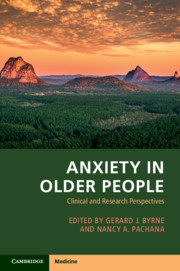Book contents
- Anxiety in Older People
- Anxiety in Older People
- Copyright page
- Contents
- Contributors
- Chapter 1 Introduction and Conceptual Overview
- Chapter 2 Epidemiology, Risk and Protective Factors
- Chapter 3 Diagnosis of Anxiety Disorders in Older Adults
- Chapter 4 Subthreshold Anxiety in Later Life
- Chapter 5 Cross-cultural Issues in Late-Life Anxiety
- Chapter 6 Clinical Assessment of Late-Life Anxiety
- Chapter 7 Late-Life Anxiety and Comorbid Depression
- Chapter 8 Anxiety and Cognitive Functioning
- Chapter 9 Anxiety in Parkinson’s Disease
- Chapter 10 Anxiety in Older Adults across Care Settings
- Chapter 11 Psychosocial Treatment of Anxiety in Later Life
- Chapter 12 Pharmacological Treatment of Anxiety in Later Life
- Chapter 13 Animal Models in Anxiety Research
- Chapter 14 Late-Life Anxiety
- Index
- References
Chapter 10 - Anxiety in Older Adults across Care Settings
Published online by Cambridge University Press: 08 March 2021
- Anxiety in Older People
- Anxiety in Older People
- Copyright page
- Contents
- Contributors
- Chapter 1 Introduction and Conceptual Overview
- Chapter 2 Epidemiology, Risk and Protective Factors
- Chapter 3 Diagnosis of Anxiety Disorders in Older Adults
- Chapter 4 Subthreshold Anxiety in Later Life
- Chapter 5 Cross-cultural Issues in Late-Life Anxiety
- Chapter 6 Clinical Assessment of Late-Life Anxiety
- Chapter 7 Late-Life Anxiety and Comorbid Depression
- Chapter 8 Anxiety and Cognitive Functioning
- Chapter 9 Anxiety in Parkinson’s Disease
- Chapter 10 Anxiety in Older Adults across Care Settings
- Chapter 11 Psychosocial Treatment of Anxiety in Later Life
- Chapter 12 Pharmacological Treatment of Anxiety in Later Life
- Chapter 13 Animal Models in Anxiety Research
- Chapter 14 Late-Life Anxiety
- Index
- References
Summary
The presentation of anxiety in older adults can differ across treatment and care settings. Therefore, providers must be mindful of these differences in order to adjust assessment and identify appropriate interventions to address the impact of anxiety on the patient and, in many cases, their overall health. This chapter aims to provide a brief description of anxiety across settings for older adults. The chapter will address anxiety in subacute treatment settings, home-based care, long-term care, and palliative/hospice care environments. It is important to remember that in these settings anxiety is often a secondary issue that accompanies acute, chronic, and terminal disease processes. Therefore, in addition to assessment and intervention, the impact of anxiety on the disease and treatment processes is also discussed in relation to overall health and treatment outcomes.
- Type
- Chapter
- Information
- Anxiety in Older PeopleClinical and Research Perspectives, pp. 157 - 172Publisher: Cambridge University PressPrint publication year: 2021
References
- 2
- Cited by

